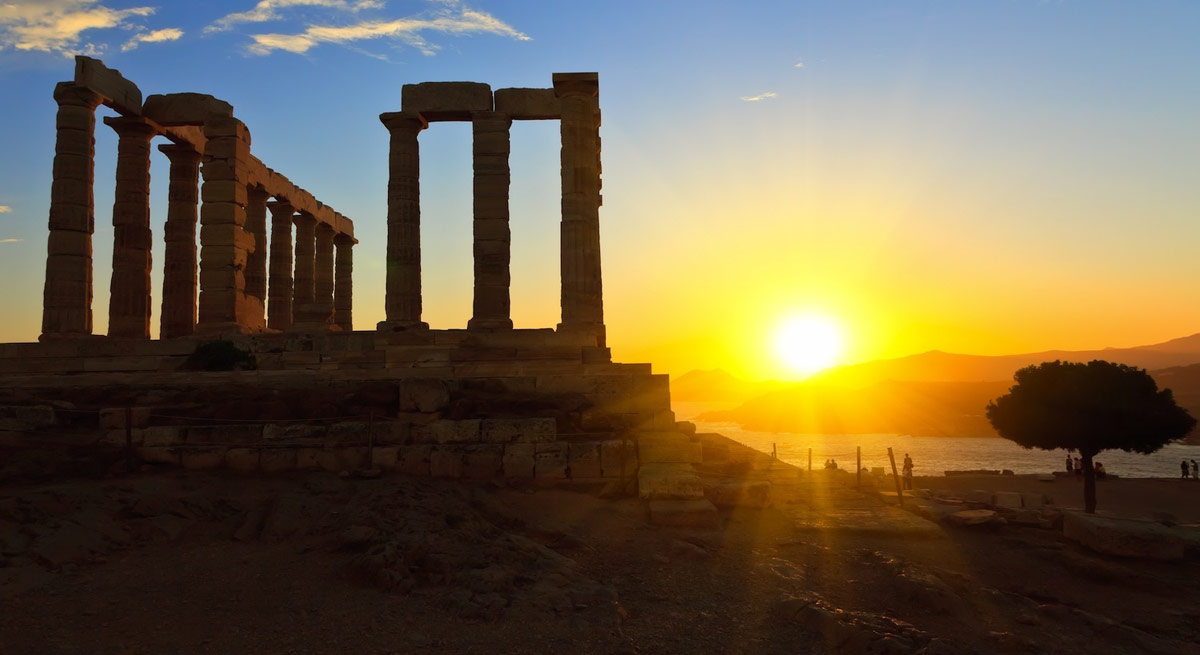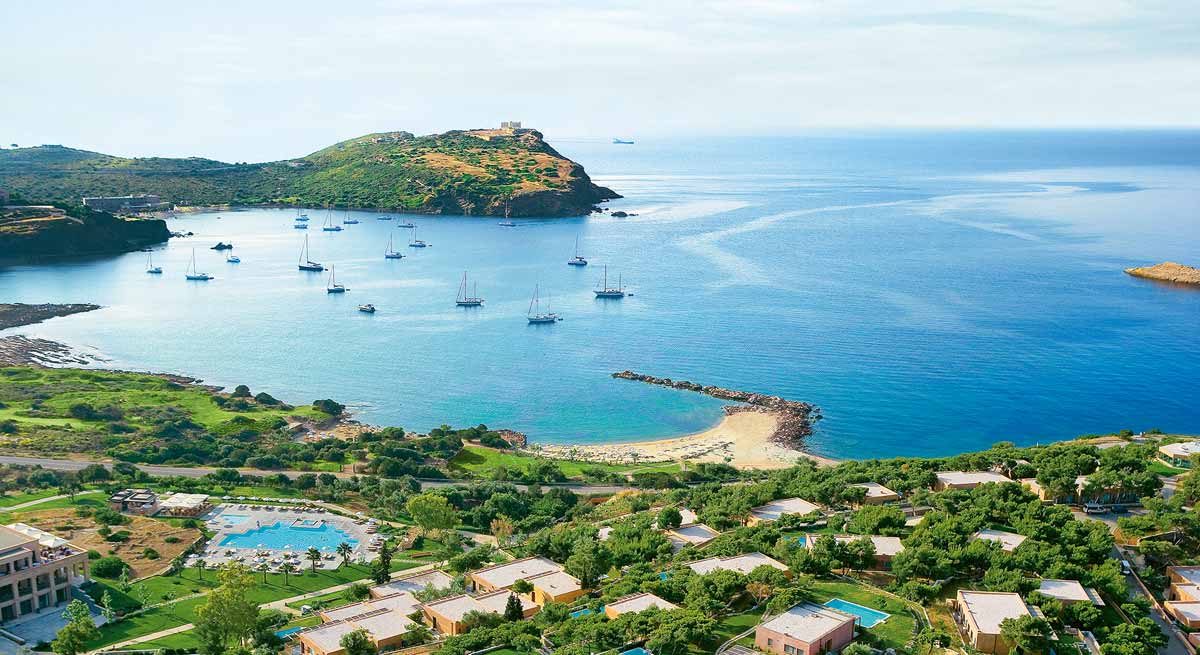SOUNIO
Cape Sounion (Modern Greek: AκρωτήριοΣούνιο, transliterated AkrotírioSoúnio, pronounced [akroˈtirʝo ˈsuɲo]; Ancient Greek: ἌκρονΣούνιον, ΆkronSoúnion; Venetian: Capo Colonne, "Cape of Columns") is a promontory located 69 kilometres (43 mi) south-southeast of Athens, at the southernmost tip of the Attica peninsula in Greece.
Cape Sounion is noted as the site of ruins of an ancient Greek temple of Poseidon, the god of the sea in classical mythology. The remains are perched on the headland, surrounded on three sides by the sea. The ruins bear the deeply engraved name of English Romantic poet Lord Byron (1788–1823). The site is a popular day-excursion for tourists from Athens, with the sunset over the Aegean Sea, as viewed from the ruins, a sought-after sight.
According to Greek Mythology, Cape Sounion is the spot where Aegeus, king of Athens, leapt to his death off the cliff, thus giving his name to the Aegean Sea.[citation needed] The story goes that Aegeus, anxiously looking out from Sounion, despaired when he saw a black sail on his son Theseus's ship, returning from Crete. This led him to believe that his son had been killed in his contest with the dreaded Minotaur, a monster that was half man and half bull. The Minotaur was confined by its owner, King Minos of Crete, in a specially designed labyrinth. Every year, according to the myth, the Athenians were forced to send seven men and seven women to Minos as tribute. These youths were placed in the labyrinth to be devoured by the Minotaur. Theseus had volunteered to go with the third tribute and attempt to slay the beast. He had agreed with his father that if he survived the contest, he would hoist a white sail on his return. In fact, Theseus had successfully overcome and slain the Minotaur, but tragically had simply forgotten about the white sail.
The earliest literary reference to Sounion is in Homer's poem the Odyssey, probably composed in the 8th century BC. This recounts the mythical tribulations suffered by Greek hero Odysseus in a gruelling 10-year sea-voyage to return to his native island, Ithaca, in the Ionian Sea, from the sack of Troy. This ordeal was supposedly inflicted upon him by Poseidon, to whom the temple at Sounion was dedicated. The story recounts that as the various Greek commanders sailed back from Troy, the helmsman of the ship of King Menelaus of Sparta died at his post while rounding "holy Sounion, cape of Athens". Menelaus landed at Sounion to give his companion full funeral honours (i.e., cremation on a funeral pyre on the beach).
The Greek ships were then caught by a storm off Cape Malea and scattered in all directions. Ancient Greek religion was essentially propitiatory in nature, i.e., based on the notion that to avoid misfortune, one must constantly seek the favour of the relevant gods by prayers, gifts and sacrifices. To the ancient Greek, every natural feature, e.g. hill, lake, stream or wood, was controlled by a god. A person about to swim in a river, for example, would say a prayer to the river-god, or make an offering to that god's shrine, to avoid the chance of drowning.

The gods were considered immortal and could change shape, become invisible and travel anywhere instantaneously. But in many other respects they were considered similar to humans. They shared the whole range of human emotions, both positive and negative. Thus, in their attitudes towards humans, they could be both benevolent and malicious. Also like humans, they had family and clan hierarchies. They could even mate with humans, and produce demi-gods.
In a maritime country like Greece, the god of the sea occupied a high position in the divine hierarchy. In power, Poseidon was considered second only to Zeus (Jupiter), the supreme god of the Olympian pantheon. His implacable wrath, manifested in the form of storms, was greatly feared by all mariners. In an age without mechanical power, storms very frequently resulted in shipwrecks and drownings.
The temple at Cape Sounion, Attica, therefore, was a venue where mariners, and also entire cities or states, could propitiate Poseidon by making animal sacrifice or leaving gifts.
The temple of Poseidon was constructed in 444–440 BC, over the ruins of a temple dating from the Archaic period. It is perched above the sea at a height of almost 60 metres (200 ft). The design of the temple is a typical hexastyle, i.e., it had a front portico with six columns. Only some columns of the Sounion temple stand today, but when intact it would have closely resembled the contemporary and well-preserved Temple of Hephaestus beneath the Acropolis, which may have been designed by the same architect.
As with all Greek temples, the Poseidon building was rectangular, with a colonnade on all four sides. The total number of original columns was 34: 15 columns still stand today. The columns are of the Doric Order. They were made of locally quarried white marble. They were 6.10 m (20 ft) high, with a diameter of 1 m (3.1 ft) at the base and 79 cm (31 inches) at the top.
At the centre of the temple colonnade would have been the hall of worship (naos), a windowless rectangular room, similar to the partly intact hall at the Temple of Hephaestus. It would have contained, at one end facing the entrance, the cult image, a colossal, ceiling-height (6 metres (20 ft)) bronze statue of Poseidon. Probably covered in gold leaf, it may have resembled a contemporary representation of the god, appropriately found in a shipwreck, shown in the figure above. Poseidon was usually portrayed carrying a trident, the weapon he supposedly used to stir up storms. On the longest day of the year, the sun sets exactly in the middle of the caldera of the island of Patroklos, the extinct volcano that lies offshore, suggesting astrological significance for the siting of the temple. The temple of Poseidon was destroyed in 399 by Emperor Arcadius.
Archaeological excavation of the site in 1906 uncovered numerous artifacts and inscriptions, most notably a marble kouros statue known as the SounionKouros and an impressive votive relief, both now in the Athens National Archaeological Museum. A column from the temple can be seen in the British Museum.

Elements
- Luxury Travel Service
- Theodoros Papandreou
- Laodikias 123 Nikaia Postcode 18451
- Privacy Policy
Menu

Number ΕΟΤ: 0207E8000055031
Copyright 2016 - 2019 © All rights Reserved. Designed by nextlevelweb.gr
